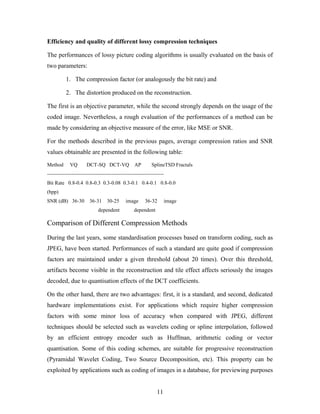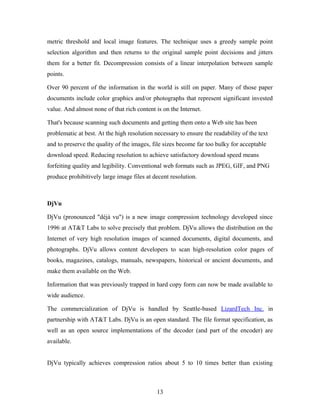The document provides information on various techniques for image compression, including lossless and lossy compression methods. For lossless compression, it describes run-length encoding, entropy coding, and area coding. For lossy compression it discusses reducing the color space, chroma subsampling, and transform coding using DCT and wavelets. It also covers segmentation/approximation methods, spline interpolation, fractal coding, and bit allocation techniques for optimal compression.
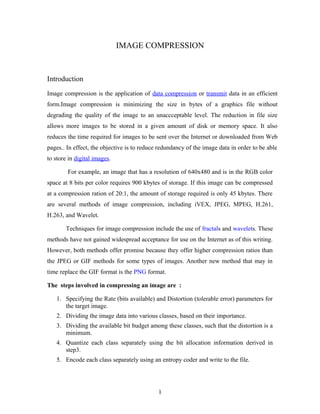
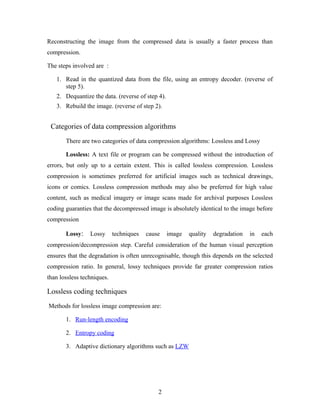
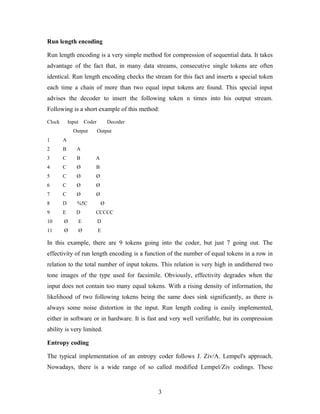
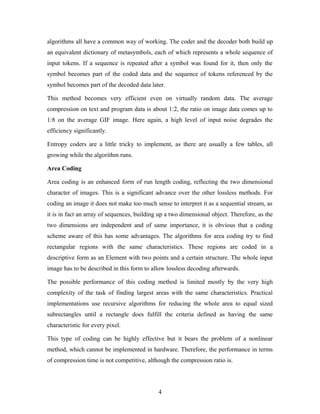
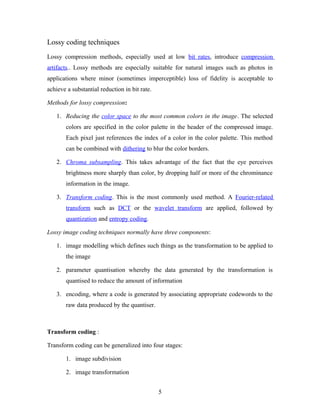

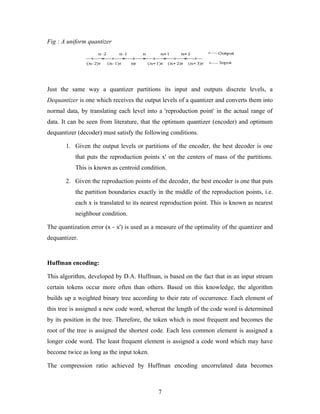
![something like 1:2. On slightly correlated data, as on images, the compression rate may
become much higher, the absolute maximum being defined by the size of a single input
token and the size of the shortest possible output token (max. compression = token
size[bits]/2[bits]). While standard palletised images with a limit of 256 colours may be
compressed by 1:4 if they use only one colour, more typical images give results in the
range of 1:1.2 to 1:2.5.
The JPEG and MPEG standards are examples of standards based on transform coding.
Segmentation and approximation methods
With segmentation and approximation coding methods, the image is modelled as a
mosaic of regions, each one characterised by a sufficient degree of uniformity of its
pixels with respect to a certain feature (e.g. grey level, texture); each region then has
some parameters related to the characterising feature associated with it.
The operations of finding a suitable segmentation and an optimum set of approximating
parameters are highly correlated, since the segmentation algorithm must take into account
the error produced by the region reconstruction (in order to limit this value within
determined bounds). These two operations constitute the logical modelling for this class
of coding schemes; quantisation and encoding are strongly dependent on the statistical
characteristics of the parameters of this approximation (and, therefore, on the
approximation itself).
Classical examples are polynomial approximation and texture approximation. For
polynomial approximation regions are reconstructed by means of polynomial functions in
(x, y); the task of the encoder is to find the optimum coefficients. In texture
approximation, regions are filled by synthesising a parametrised texture based on some
model (e.g. fractals, statistical methods, Markov Random Fields [MRF]). It must be
pointed out that, while in polynomial approximations the problem of finding optimum
coefficients is quite simple (it is possible to use least squares approximation or similar
exact formulations), for texture based techniques this problem can be very complex.
Spline approximation methods
These methodologies fall in the more general category of image reconstruction or sparse
8](https://image.slidesharecdn.com/imagecompression-130831121356-phpapp02/85/Image-compression-8-320.jpg)

![The Rate-Distortion theory is often used for solving the problem of allocating bits to a set
of classes, or for bit rate control in general. The theory aims at reducing the distortion for
a given target bit rate, by optimally allocating bits to the various classes of data. One
approach to solve the problem of Optimal Bit Allocation using the Rate-Distortion theory
is explained below.
Initially, all classes are allocated a predefined maximum number of bits.
For each class, one bit is reduced from its quota of allocated bits, and the distortion
due to the reduction of that 1 bit is calculated.
Of all the classes, the class with mininum distortion for a reduction of 1 bit is noted,
and 1 bit is reduced from its quota of bits.
The total distortion for all classes D is calculated.
The total rate for all the classes is calculated as: R = p(i) * B(i), where p is the
probability and B is the bit allocation for each class.
Compare the target rate and distortion specifications with the values obtained above.
If not optimal, go to step 2.
In the approach explained above, we keep on reducing one bit at a time till we achieve
optimality either in distortion or target rate, or both. An alternate approach which is also
mentioned in [1] is to initially start with zero bits allocated for all classes, and to find the
class which is most 'benefitted' by getting an additional bit. The 'benefit' of a class is
defined as the decrease in distortion for that class.
Fig: 'Benefit' of a bit is the decrease in distortion due to receiving that bit.
As shown above, the benefit of a bit is a decreasing function of the number of bits
allocated previously to the same class. Both approaches mentioned above can be used to
the Bit Allocation problem.
10](https://image.slidesharecdn.com/imagecompression-130831121356-phpapp02/85/Image-compression-10-320.jpg)
